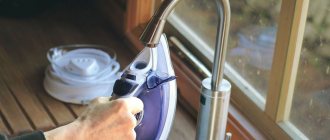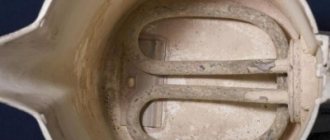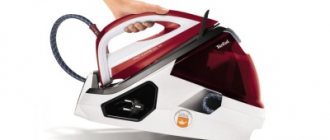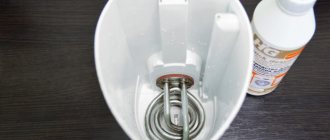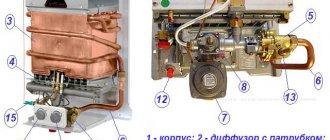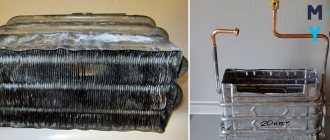Like any device whose operating principle is related to heating the liquid inside, a household steam generator is susceptible to contamination as a result of the formation of sediment, so it is important to know how to descale a steam generator at home.
A steam generator is a convenient and practical thing that helps save time and makes life much easier. This article will help you figure out how to clean the device.
An iron with a steam generator is a convenient and practical thing that helps save time and makes life much easier
Cleaning methods at home
The equipment must work without failures and ensure the performance of direct functions. The service life depends on proper care and operation. There are different types of steam generators, and some can be cleaned yourself, while others cannot.
- The pump device provides for the release of steam under high pressure by pressing a special button. This steamer is very convenient and effective, but it is unlikely that it can be descaled at home. There is a high risk of damaging the equipment, so it is better to opt for service.
- The gravity-fed device is not as effective, but not difficult to maintain. In order to get rid of scale and carbon deposits, it is enough to use special descaling products or prepare a mixture at home.
Let's start by finding out what types of steam generators there are. There are two of them:
- pump-action – the accumulated steam comes out in a powerful stream when you press the button;
- flow-through - steam constantly flows to the fabric, evaporating from the boiler.
The second type does not have complex systems, so you can clean it at home. The process is divided into two stages: cleaning the boiler itself, and then the iron.
Clean the steam generator when it is cold, following these steps.
- Empty the water from the boiler.
- Unscrew the descaling valve.
- Pour diluted boiler cleaner into the hole.
- Return the valve to its place and close the tank.
- Having set the maximum heating, turn on the device.
- Iron the fabric that you don’t mind, constantly applying steam. When pure steam comes out, you need to stop ironing.
- Turn off the iron and let it cool.
- Drain the cooled water and rinse the container.
- Close the valve and wipe the device.
If your appliance is heavily clogged with lime, small pieces of limescale may jump out of the holes during cleaning, creating splashes. You need to act carefully so that boiling water does not get on your skin: do not point the sole in your direction or at others. An iron with a built-in water tank can be cleaned in a variety of ways. Now we'll tell you about them.
To clean the Teflon coating on the sole of the iron, you need to heat it a little and then rub it with laundry soap. Then take a wooden or plastic spatula and remove the resulting coating. The carbon deposits will be removed along with it.
Instead of soap, dishwashing detergent applied to a sponge is suitable. You need to slightly heat the iron, unplug it and wipe the soleplate. At the end of cleaning, the sole should be rinsed and dried.
Lemon acid
Citric acid is the most gentle substance and does not have such an aggressive reaction as vinegar. Take 30 g of citric acid (powder) per glass and stir. The solution is poured into the water tank and allowed to stand for about 15 minutes, after which it is turned on to maximum. Lightly shaking the iron, steam the unwanted piece of fabric until the water has completely evaporated. After turning it off, let the iron cool and rinse it.
All that remains is to wipe the device - and that’s it. Now you can check the quality of cleaning on unwanted material. Fill the reservoir with water, wait for the heating indicator to go out and iron the fabric. If there are no dirty stains or pieces of lime left on it, then the cleaning can be considered successful.
Antiscale
To clean the device using a special anti-scaling product, you don’t need to invent anything special. Take the package of the substance (tablet, powder or gel) and read the instructions. Dissolve the concentrate in water and act according to the instructions.
Using vinegar removes lime and rust from the iron soleplate. The solution is prepared from 200 ml of vinegar and 1 liter of distilled water. Then clean the tank as described in the case of citric acid (evaporate the solution from the boiler at maximum power).
To clean the sole we need a deep container like a baking tray.
- Having placed the back part of the sole on a raised surface (0.5 cm), fill the dishes to a height of 1.5-2 cm.
- We set the structure to heat up, and set the regulator on the iron to the “max” position.
- Bring to a boil, let cool, then rinse the sole.
If you are satisfied with the quality of cleaning, dry the iron and test iron on unnecessary fabric.
Mineral water
Mineral water can also remove scale. To do this, you need to pour mineral water into the boiler. Then you need to heat the device to maximum and iron the unnecessary fabric, constantly releasing steam. When all the water has evaporated, the device must be turned off and allowed to cool. After this, you need to rinse the inside of the container, tighten the valve and wipe the device. Ready.
Soda
Soda is a solution of vinegar and soda. The fact is that when these two substances are mixed, a violent reaction occurs with the release of gas bubbles. To clean the soles from plaque, you need to add 20 g of soda to 100 ml of vinegar and wipe the warm surface with this solution.
Descaling Philips steam generators can be divided into 3 options:
- Using the self-cleaning function.
- Subject to the use of folk remedies.
- With the help of special drugs.
Depending on the selected steam generator model, the methods for descaling it will vary. If the device is equipped with an ANTI-CALC cartridge, then it will need to be replaced to get rid of limescale.
The iron will notify you about the accumulation of limescale in several ways:
- the indicator will light up;
- a sound signal will appear;
- the device will stop producing steam.
Replacing the cartridge is not difficult. The procedure is carried out in several stages:
- The device is removed from the base. It is inside it that the cartridge is located.
- It is taken out, the rubber pad, which is located at the top, is removed from the old part.
- The new cartridge is placed in the hole on the base station, not forgetting to put the rubber pad on it.
- The lid is closed.
We suggest you familiarize yourself with how you can descale your iron.
To use it, you need to perform the following algorithm of actions:
- Unplug the device and wait until it cools down completely.
- Prepare a container to collect water. Its capacity should not be less than 0.25 liters.
- The Easy De-Calc Plus valve is turned in the opposite direction to the clockwise direction. After removing it, the water is drained. Salt deposits will be visible in it.
- The valve is returned to its place.
To completely descale the appliance, it is recommended to perform a deep cleaning. It should be done at least once a month. The procedure is carried out after draining the water from the Easy De-Calc Plus valve.
It goes like this:
- Pour 0.5 liters of clean water into the tank.
- The valve is put in place.
- The device is connected to the network.
- After heating it, the fabric begins to steam until the water has completely evaporated.
- After ironing is completed, the device is disconnected from the network. When it cools down, the water is drained from it.
Cleaning the Philips steam generator model with the Smart function:
- The reservoir is filled halfway with water.
- The device is connected to the network.
- Place the iron in a special container to drain water and release steam (it is included in the kit).
- Press and hold the button labeled Calc Clean for 2 seconds. After this time, the device should beep.
- Leave the device in the container for 2 minutes. Steam and water with scale will come out of it.
- When cleaning is complete, the device stops beeping.
Buttons on the iron - answers to frequently asked questions
Modern steam irons are equipped with a number of additional functions and systems that not only make ironing easier, but also make it safer.
Fabric humidification, steam boost, vertical steaming, auto-shut-off system, anti-drip system, scale prevention - today even budget versions of irons have these functions. The most advanced models are equipped with their own steam generator and self-cleaning system.
To control operating modes, the iron's control panel has several buttons and switches.
Depending on the manufacturer and model of the device, these may be:
- Temperature regulator - is a rotating switch, while the temperature scale is often designated by the type of fabric;
- Steam regulator - is a mode switch: no steam, 1 (weak steam), 2 (medium steam), 3 (strong steam) and max (maximum steam);
- Water spray button. When pressed, the spray tip dispenses water from the reservoir;
- Steam boost button. By repeatedly pressing the button at intervals of 5 seconds, a powerful stream of steam at maximum temperature is supplied from the holes on the sole of the iron;
- Self clean system button. When you press it, the iron’s self-cleaning function of limescale and scale starts.
The self clean button appeared on irons later than others. Today it can be found on all flagship models of leading iron manufacturers (Philips, Bosch, Tefal, Braun, Scarlett, VITEK, Bork, Polaris, etc.).
To clean the steam chamber and heating elements from unwanted scale particles, you must perform the following steps:
Disconnect the iron from the mains, set the steam regulator to the OFF position; Fill the tank with water to the mark; Connect the iron to the mains, set the temperature regulator to the maximum position; After complete heating, when the thermal relay operates (the power indicator should go out), disconnect the iron from the network; Raise the iron over the bathtub or sink; Press the clean button and, without releasing it, shake the iron until about 1/3 of the water volume from the reservoir has evaporated
This must be done with extreme caution, because... boiling water will flow from the sole and steam will escape, removing existing particles of scale and other deposits; Release the clean button and gently shake the iron for 5-7 seconds; Repeat the steps described in points 6 and 7 several times until the water tank is completely empty; Plug in the iron and heat until the remaining water has completely evaporated; Disconnect the iron from the power supply, and after cooling, wipe the soleplate with a damp cotton cloth.
Why do the buttons on the iron stick or are difficult to press?
As a result of prolonged and intensive use of ironing equipment, some buttons begin to press poorly and become stuck.
Most often, this problem occurs with the steam button - when pressed, it is pressed with great difficulty, but no steam comes out.
If the steam button is broken, you can fix the problem yourself using available tools.
To do this you need:
Remove the back cover of the case. To do this, you need to unscrew 1-3 mounting screws using a regular Phillips screwdriver; Remove the top steam and spray buttons (they are not secured). Unscrew the screw that is hidden under the buttons and remove the top decorative trim on the iron handle; Remove the upper part of the case by first unscrewing the existing screws and removing the temperature regulator disk; Since the steam button on the iron is stuck, it is necessary to remove the steamer pump, disassemble it, and clean it of scale and other deposits. Assemble and put in place; Taking this opportunity, you should descale all accessible parts of the iron.
Particular attention should be paid to the tubes through which steam and water move. They often become clogged, especially if unboiled hard water from the tap is poured into the iron; Reassemble the iron in the reverse order.. VIDEO INSTRUCTIONS ” alt=””> In the same way, you can fix other problems that arose during the operation of the iron with your own hands
VIDEO INSTRUCTIONS ” alt=””> In the same way, you can fix other problems that arise during the operation of the iron with your own hands.
Why is scale dangerous?
Despite the fact that modern models have a built-in purifier, the operating instructions for the equipment emphasize the need to use purified water. Since everyone chooses their own methods of water purification, there may be times when scale does form. During ironing, yellow streaks may remain, and when steaming, lime flakes may appear on the fabric.
If the water tank becomes clogged, the equipment may fail. The flow of dirty water will leave stains on the material being processed, which will have to be washed or a special fabric cleaner must be used. Using low-quality water can damage the device beyond repair.
Scale is made up of salts, calcium and magnesium. They remain in the steam heater after the water has evaporated and form lime. Limescale can seriously damage an item: it can remain on the fabric in the form of yellow stains or white flakes.
Plaque also conducts heat poorly and does not absorb it. This means that the device will heat up for a long time, spending a lot of energy, and over time it will stop working completely.
Therefore, it is so important to clean the steam heater from it in a timely manner.
Steam generators of new models have a self-shut-off function; it is triggered when there is too much scale in the device. This technique “can” self-clean, that is, to remove scale, it is enough to turn on the cleansing mode and steam a piece of unnecessary fabric. If there is no such function, an unpleasant odor and weak steam pressure indicate the need to clean the steam generator. To achieve the best results, you should clean both the inside (water tank) and the outside (sole) of the device.
Self-cleaning
Clean products with a steam function (gravity-flow type of steam generators) at least once every 1-2 months. The procedure is also necessary if the iron has a special indicator that flashes to indicate significant contamination of the electrical appliance.
Procedure:
- prepare a bowl or basin to collect liquid;
- set the regulator to the “no steam” position and set the maximum temperature;
- fill the iron reservoir with water;
- Plug in the device; when the heating indicator goes out, turn it off;
- place the iron over the basin, shake it several times and press the steam release button;
- when the water in the tank runs out, plug in the ironing device and iron a piece of fabric several times, cleaning the sole.
Many modern models of Philips irons operate from steam stations (pump-type steam generators), which are also equipped with built-in automatic cleaning.
Does your iron have a self-cleaning system?
Not really
Easy rinsing
The procedure is intended for regular removal of scale that forms in the iron's steam generator:
the electrical device must be disconnected from the network; if the iron was working before cleaning, let it cool for 2 hours; remove the device from the steam station; remove the reservoir (if it is removable) or take the base with both hands and shake it thoroughly several times; remove the special Calc Clean valve or unscrew the steam generator cap; Carefully tilt the container over the sink or bathtub and drain all the liquid; Pour in again a small amount of purified water (about half the total volume required to fill the tank) and repeat the entire procedure 2-3 more times.
Smart calc clean
This system is a mode designed to eliminate the formed layer of scale. During cleaning, the device must be turned on:
- pour purified water into the steam generator (approximately up to half the tank);
- if the heating regulator of your model of electrical appliance has a “calc clean” position, set it;
- place a special container on a flat surface (ironing board, table with a towel laid out), place the iron on it;
- press and do not release the calc-clean button for 2 seconds until you hear short beeps indicating the start of cleaning;
- the process of removing contaminants lasts 2 minutes, short signals will be heard throughout the procedure;
- When the automatic descaling job is complete, the appliance will emit a long signal and turn off;
- wipe the iron with a clean, dry cloth and place it on the steam station;
- Drain the container and store it until next use.
The need for such cleaning will be indicated by a sound signal emitted by the steam generator and a flashing indicator light on the body or handle of the iron.
Pure steam anti-scale cartridge
It is a replaceable filter filled with a granular substance that eliminates hardness salts by converting the positive charges of calcium and magnesium ions into negative ones. This element is suitable for irons with a Perfect Care Pure steam generator.
The cartridge removes most of the organic compounds and salts from the liquid, making it possible to use tap water for ironing.
The need to replace the element is indicated by the blinking of the indicator and the sound signal of the household appliance. The service life of the steam generator part depends on the intensity of use of the iron and, as a rule, ranges from 1 to 3 months, after which the old cartridge is thrown away and a new one is installed.
Loading …
Tips for care and use
Tefal steam generators are usually equipped with a powerful cleaner, so you can safely use tap water. The only disadvantage of the protective function is the appearance of yellow flakes when using water with a high salt content. In this case, it is better to use purchased clean water. The tank can be cleaned like a regular container, rinsed under running water.
Philips household steam generators are equipped with built-in descaling systems. They are called differently in different models, but the essence is the same: when a certain indicator on the device starts flashing, a cleaning procedure should be carried out. It is performed according to the operating instructions for a specific device and, as a rule, takes no more than 2 minutes. If cleaning does not occur, the steam generator will automatically turn off the steam function.
Although Philips has developed a special self-cleaning function, if you regularly use low-quality water, thin and curved channels prevent the release of flakes that form in the tank. Since the purifier does not always cope with the complex chemical composition of water, it is important to prevent the presence of liquid residues in the tank after completion of work and periodically rinse the container.
With careful operation of equipment, following the manufacturer’s recommendations, you can ensure a long service life. It is important to correctly select the technical characteristics of the equipment that would meet the requirements of the future application.
Modern steamers are equipped with self-cleaning systems, and different manufacturers have different designs. To descale a Philips steam generator, inside of which there is a special container for collecting sediment, you need to lower the lock carriage down on the back panel of the iron and remove the container from the iron. This needs to be done over the sink. After cleaning it from plaque, wipe it and put it in place, then lock the lock by lifting the lock up.
In order to clean the Tefal steam generator at home, you need to use the SelfClean button. To clean, fill the iron completely with water and plug it in, holding it over a sink or basin. Set the ironing and steaming mode to maximum, wait until the heating indicator goes out. After this, press the SelfClean button, holding it in this position until all the water has drained out.
Water will leak out of the iron - don't be alarmed. At first it will be brown or flaky. Transparency will gradually return: this means that the iron has been cleaned. If you are satisfied with the result, rinse the tank, fill it with water and do a test ironing. If not, repeat the cleaning again.
Some models of Philips irons equipped with a DE-CALC indicator can be cleaned in the same way as Tefal. You can understand that it is time for cleansing when you see a flashing light. Modern irons with steam generators can not only give signals that you need to get rid of scale, but also turn off completely. If this happens to you, don’t worry: this is how the breakdown protection system works. Clean the device from lime and it will turn on.
We suggest you familiarize yourself with the automatic washing machine not heating the water - reasons
So that the steam generator does not have to be urgently rescued, there is no need to bring it to this state. Here are a few tips that you can follow to extend the life of your equipment and keep it in good shape:
- Rinse the device with clean water before and after use. Drain off the remaining liquid.
- Do not try to clean pump steam generators at home - use the services of service centers.
- Fill the device only with clean, soft water, preferably distilled or filtered.
- If finances allow, you can purchase a water softener. They are sold in household chemical departments.
- When cleaning the surface of the steam generator, do not use metal sponges or brushes.
- Harsh, abrasive products are contraindicated with Teflon and ceramic coatings.
- Salt should also not be used for cleaning.
- Always place the steam generator with its nose facing up.
- Before first use, read the instructions for use and manufacturer's recommendations.
Using a Philips steam generator results in scale formation. This process is inevitable if ordinary tap water is poured into the device. The harder it is, the faster the salts clog the tank.
To avoid failure of the device, you need to regularly descale it. Our recommendations will tell you how to clean the Philips steam generator from scale inside.
Reasons for contamination of ceramic-coated devices
One of the reasons for the formation of plaque and stains on the soleplate of an electrical device is the use of ordinary tap water during ironing.
In the absence of regular self-cleaning of the device, sediment will gradually accumulate, which will lead to a deterioration in the pressure of the escaping steam during operation of the device and a decrease in the quality of ironing.
The following factors also influence the appearance of contamination on a ceramic-coated product:
- failure to comply with the temperature conditions recommended by the manufacturer of the device for ironing certain types of fabrics;
- prolonged contact of the hot sole with synthetics;
- contact with the ironing element of plastic, polyethylene and other adhesive materials, which melt under the influence of high temperature and stick to the hot surface.
This article will tell you how to clean a Philips iron from scale.
Is there carbon deposits on the soleplate of your iron?
Not really
Recommendations
To ensure that your iron serves you as long as possible, use ONLY purified water in it:
- distilled;
- demineralized;
- from a reverse osmosis filter;
- tap water using water softeners (for irons).
Despite the fact that manufacturers boldly claim that built-in self-cleaning filters will cope with hard water, this is not entirely true. The filters will last for the entire warranty period, but after that a breakdown may occur. The health of your device is in your hands. Take care of it, and the iron will please you for a long time.
The steam generator is practically indispensable in the household. This multifunctional device saves time and effort and makes life easier. With its help, you can easily iron linen and clothes, clean carpets, curtains, tiles and much more.
To prevent scale, it is recommended to pour only distilled water into steam generators. But this is not always possible. Tap water contains a large amount of salts, which lead to the formation of limescale. It can greatly spoil the quality of the equipment or even disable it.
Recommendations for operating and cleaning Philips steam generators from scale:
Do not fill the device with tap water. It must be passed through a filter that reduces the amount of salts.
Scale will not form if you use distilled water.
- After using the iron, the water must be drained.
- When cleaning the device, be careful not to burn yourself.
- It is necessary to drain the water from the steam generator only when the device has completely cooled down.
- If after descaling the equipment does not steam, it must be taken to a service center.
Prevention measures
In order for the steam generator to last as long as possible and be less susceptible to scale formation, it is recommended to follow a number of simple rules. For example, only filtered or melted water should be poured into the tank. Tap water contains a large amount of salts and impurities, so it is prohibited to use it unfiltered. Boiled water is also not suitable for steam cleaners, as it forms sediment during the boiling process. As for distilled water, it has too high a vaporization temperature, so it is far from the best option. Spring water contains a large amount of minerals and salts, which quickly turn into scale, and a special flavored liquid often leaves stains on clothes.
If you use the device regularly, it should be cleaned at least 2 times a month, and after each use, be sure to drain the remaining water from the reservoir. It is not recommended to clean the steam cleaner using hard sponges and abrasive substances, as well as products containing hydrochloric acid.
See below for the steam generator cleaning method.
Rules for cleaning at home
How to clean the device yourself? Citric acid removes scale well. To prepare the solution you need the following ingredients:
- hot water (40 degrees) - 1 l;
- citric acid - 25g.
It is necessary to mix the solution thoroughly so that all the crystals dissolve, and then begin cleaning the steam generator. The cleaning rules are as follows:
- The resulting mixture must be poured into a tank intended for water. If the device has a capacity larger than 1 liter, you can proportionally increase the ingredients to the required volume.
- Leave the solution in the tank for 20 minutes.
- Turn on the steam generator at maximum temperature.
- Start the operating mode with steam release until all the liquid has evaporated. If citric acid is used as an iron cleaner, it is advisable to iron unwanted fabric or old cotton clothing while cleaning.
- After the solution has completely evaporated, add clean water and leave in operating mode for 10-15 minutes.
- Drain off any remaining liquid and rinse with purified water twice more.
Along with lemon juice, acetic and hydrochloric acids can act as a cleaner.
Mineral water
A safe method for cleaning a steam generator is to use mineral water.
Algorithm of actions:
- fill the water container with mineral water;
- heat the iron as high as possible;
- Allow the liquid to completely evaporate using steam mode.
After this, you should do the same steps with ordinary boiled water.
Types of steam heaters
Cleaning the steam generator depends on its type. There are two of them:
- Pump devices. In such steam heaters, steam is released due to the high pressure that occurs when water evaporates. Pump steam generators are convenient and easy to use. However, they are quite expensive, and their design is complex. Therefore, such devices cannot be cleaned yourself. If problems arise, please contact the service center. In addition, it is recommended to take pump steam generators for preventive inspection 1-2 times a year.
- Gravity-flow devices. In these steam heaters, steam is supplied gradually as it evaporates. Gravity-flow generators are easy to use, and you can clean them from scale using improvised means. It is recommended to clean them once a month for prevention, especially if they are used constantly.
Irons from brands such as Philips and Tefal already have a descaling function, so you don’t have to bother with them. As for other devices, you need to wash them yourself. But first, let’s figure out why we need to descale equipment at all?
Effective means
Today there are many products on sale for cleaning household appliances from carbon deposits and scale. Their advantage is the speed of cleaning, and also the fact that there is no need to prepare separate compositions. You simply pour the finished liquid from the bottle into the steam generator tank and use the device after a short time.
Those who want to save money and eliminate the use of aggressive chemicals in everyday life can safely use vinegar and acid.
Citric acid is used to combat scale in a variety of devices
Soap solution
A soap solution is also used as a gentle cleaning agent that removes carbon deposits from the soleplate of the device. This is especially true for Teflon coating. It is necessary to mix liquid soap and water in a ratio of 1:3, respectively, moisten the sponge with the mixture and thoroughly wipe the contaminated surface.
Vinegar soda
A soda-vinegar solution does an excellent job of removing limescale. Mix 20 g of soda with 100 ml of vinegar and wipe the resulting mixture on a slightly heated surface. The Teflon coating can be cleaned with laundry soap. To do this, slightly heat the steam iron and rub the soap on the sole, then remove the resulting deposit with a wooden spatula. Along with the soap, the carbon deposits will also be removed.
We suggest you read How to clean a burnt kettle
There are special products that help clean steam generators from scale. It is best to buy cleaners of the same brand as the steam heater. Some manufacturers, for example, Karcher, sell the cleaning product immediately along with the equipment. Greenamp;Clean and Antiscale have proven themselves well.
How to clean
Cleaning the steam generator from scale is not difficult at all. You need to follow the rules and precautions. Do not forget that each household appliance is equipped with instructions for use and care. It is necessary to focus on it first.
Before starting work, the unit must be in a cold state and disconnected from the power supply at least two hours before cleaning.
You need to open the boiler lid and drain the water from it. You will have to tilt it over the sink or place it on the edge of the table and bring a container to the hole to collect water.
Then place the steam generator on its side, insert a small funnel of suitable size into the boiler hole, and pour in distilled water or anti-scale reagent liquid - “Active”, “Antinscale”, etc. Suitable home remedies include citric acid, vinegar, soda, mixed with water in certain proportions.
Close the reservoir opening, shake the contents and leave for 45 minutes to an hour. Then shake the steam generator again so that the reagent can better corrode the lime deposited on the walls.
IMPORTANT: The steam generator must not be plugged into the power supply during cleaning, so that lime along with the steam does not flow through the main channels of the iron and settle in them. It must remain in the tank. After an hour, drain the liquid and rinse the container with cold water. If necessary, if the plaque was strong and old, the procedure is repeated.
Vinegar
Models without the above function can be cleaned yourself. Thus, citric acid is a common remedy that is used in the fight against scale.
In this case, it is necessary to clean the steam generator in stages:
- dissolve 1 tbsp. l. a tablespoon of citric acid in 1 liter of water;
- pour the resulting solution into the iron reservoir and leave for 20 minutes;
- turn on the maximum steam supply and hold until the liquid has completely evaporated;
- Rinse the tank thoroughly and fill it with clean water;
- turn on the maximum steam mode again until the liquid has completely evaporated and any remaining contaminants have been removed.
During cleaning, you need to turn on the maximum steam supply mode and wait until the liquid from the tank has completely evaporated
After all the steps taken, test the device by steaming a small piece of fabric. Clean steam should come out of the device freely without any foreign particles.
Another effective and inexpensive steam generator cleaner is table vinegar. Using this product you can achieve a double effect: clean the tank and remove carbon deposits from the sole of the iron. Cleaning the tank is similar to cleaning with citric acid.
The deposits are removed in the following sequence:
- take a frying pan with high sides and place two small wooden blocks on its bottom;
- place the switched-off iron on the bars so that its sole does not come into contact with the bottom of the frying pan;
- dilute 200 ml of vinegar in 1 liter of water and pour into the frying pan such an amount of the resulting mixture so that the bottom of the device “sinks” by 1.5 cm;
- On the device, set the steam level regulator to maximum;
- bring the liquid to a boil;
- after 1.5-2 minutes, remove the pan from the heat;
- Wash the soleplate of the iron thoroughly with clean water and let the device dry for 24 hours.
The fumes from liquids containing citric acid and vinegar have a rather pungent odor. Therefore, before cleaning the steam generator, it is recommended to set the window to ventilation mode.
The more carefully you take care of your equipment, the longer it will last. Therefore, preventive actions are very important. If possible, only fill the steam generator with clean water. After using the device, drain the liquid from the reservoir. Do not wait for a critical amount of scale and soot to form; carry out intermediate cleaning.
You can descale the steam generator yourself using vinegar. There are several ways to do this.
Method 1
- Pour an aqueous solution of vinegar into the boiler (1:1, no more than 25% of the total volume).
- Turn on the device at full power.
- Turn on steaming and go over the fabric several times.
- Pour distilled water and iron the fabric.
- Repeat the procedure.
Method 2
- Make a mixture of soda and vinegar (1:5).
- Pour the resulting liquid onto a cloth and wipe the surface of the steam heater.
- Rinse with warm water and wipe dry.
- Steam the unnecessary fabric.
Method 3
It is suitable for cleaning the soleplate of an iron with a steam generator. You can take not only vinegar, but also citric acid:
- Place two wooden blocks on the bottom of a deep frying pan.
- Place the iron on them with the sole down so that it does not touch the bottom of the container.
- Dilute vinegar in water (1:5) and pour it into the frying pan so that the iron goes 1-1.5 cm into it.
- Set the steam level to maximum.
- Boil the liquid in a frying pan for 1.5-2 minutes.
- Rinse the sole and dry for 24 hours.
Video
In order to understand the nuances of cleaning steam generators, check out the presented videos:
Young mother, wife and part-time freelancer. Being a lawyer by training, I am accustomed to collecting and providing the most complete and reliable information. Constantly improves in the professional field and strives for personal growth and development.
Found a mistake? Select the text with the mouse and click:
Fresh lemon is not only suitable for tea: clean dirt from the surface of an acrylic bath by rubbing with half a cut citrus, or quickly wash the microwave by placing a container of water and lemon slices in it for 8-10 minutes at maximum power. The softened dirt can simply be wiped off with a sponge.
The easiest way to remove scale and carbon deposits from the soleplate of the iron is with table salt. Pour a thick layer of salt onto the paper, heat the iron to maximum and run the iron over the salt bed several times, applying light pressure.
The habit of using an automatic washing machine “sparingly” can lead to the appearance of an unpleasant odor in it. Washing at temperatures below 60℃ and short rinses allow fungi and bacteria from dirty clothes to remain on internal surfaces and actively multiply.
Threads made of gold and silver, which were used to embroider clothes in the old days, are called gimp. To obtain them, the metal wire was pulled for a long time with pliers to the required fineness. This is where the expression “to drag out the rigmarole” came from - “to do long, monotonous work” or “to delay the completion of a task.”
If your favorite things show the first signs of gestation in the form of untidy pellets, you can get rid of them using a special machine - a shaver. It quickly and effectively shaves off clumps of fabric fibers and returns things to their proper appearance.
Stretch ceilings made of PVC film can withstand from 70 to 120 liters of water per 1 m2 of their area (depending on the size of the ceiling, the degree of its tension and the quality of the film). So you don’t have to worry about leaks from neighbors above.
The dishwasher cleans more than just plates and cups. You can load it with plastic toys, glass lamp shades and even dirty vegetables, such as potatoes, but only without using detergents.
Before removing various stains from clothing, you need to find out how safe the selected solvent is for the fabric itself. It is applied in a small amount to an inconspicuous area of the item from the inside out for 5-10 minutes. If the material retains its structure and color, you can move on to stains.
There are special traps to combat moths. The sticky layer with which they are covered contains female pheromones that attract males. By sticking to the trap, they are eliminated from the reproduction process, which leads to a decrease in the moth population.
Cleaning the steam generator with vinegar and citric acid
Citric acid is one of the most popular anti-scale agents.
There are several ways to clean a steam generator.
Method 1
- Dilute 1 tbsp. l. acid in 1 liter of water.
- Pour the resulting liquid into the reservoir.
- After 20 minutes, switch the device to maximum steam mode and leave it until the liquid has completely evaporated.
- Rinse the device well.
- Pour in clean water and evaporate it.
Nail polish remover
- Turn off the device and cool it down if it was hot.
- Drain the water from the container.
- Place the steam generator on its side.
- Remove the locking screw.
- Pour in the prepared cleaning reagent.
- Close the valve.
- Set the maximum heating level.
- Perform control steaming and make sure that scale particles do not get out.
- Turn off the steam generator and allow it to cool thoroughly.
- Drain the used liquid, rinse, wipe dry and can be used as usual.
Rub the sole with a slightly damp piece and leave for half an hour. Then wipe until clean. The carbon deposits will come off along with the soap scum.


